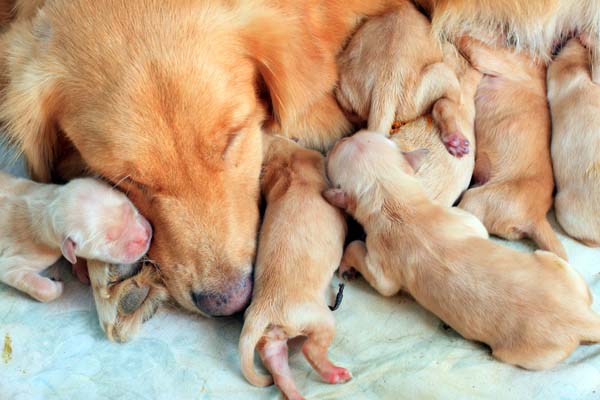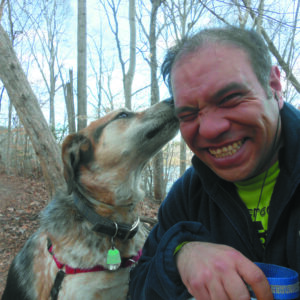Whether you have a female dog who is not spayed, or you’re just curious about dog gestation, we’re here to address the basics of dog pregnancy. One of the most common questions is, “How long are dogs pregnant?” Let’s talk about dog pregnancy and the dog gestation period.

How long are dogs pregnant?
Intact female dogs tend to go into heat, or estrus, twice each year. Every six to eight months throughout their lives, female dogs prime themselves for the rigors of child rearing. While their reproductive cycles might become erratic or less regular as they reach advanced age, unlike humans, dogs do not experience menopause, remaining fertile well into seniority.
They spend about three weeks in heat, and the last two of those weeks are prime for egg fertilization. Though there can be minor variations, depending on breeds and sizes of dog, the general answer to “How long are dogs pregnant?” is right around two months, or roughly 60 to 65 days from conception to birth. Based on our research, the average dog pregnancy seems to be right around nine weeks, or 63 days.
Signs of dog pregnancy
The next question after, “How long are dogs pregnant for?” might be “What are the signs that a dog is pregnant?” Since dog pregnancy is such a relatively rapid phenomenon, it can certainly sneak up on an unsuspecting dog owner. Tracking dog pregnancy symptoms requires a keen and observant eye, since a dog at the onset of fertility looks very much like she would at several weeks pregnant. The most frequently cited sign of pregnancy in dogs is red, enlarged or swelled nipples, which also happen when a dog is in heat. Over the course of the dog gestation period, the teats will grow even larger as she begins to produce milk for forthcoming puppies.
In answering “how long are dogs pregnant,” it’s important to remember that, for larger dogs especially, the swollen abdomen that we notice in humans might not present until the last three weeks of pregnancy. For the first couple of weeks of a dog’s pregnancy, she may lose her appetite and become lethargic. Vomiting, which we associate with morning sickness in humans, may occur, but is one of the less common dog pregnancy symptoms. Along with the changes in the size of her teats, markedly lower energy and appetite levels may be the best early indicators for dog owners unacquainted with the process.
Dog gestation period — a breakdown
Another question that follows, “How long are dogs pregnant for?” — what exactly happens while dogs are pregnant? For the first two to three weeks of a dog’s pregnancy, she may experience changes in mood, attitude and appetite. Her energy will decrease and she will be less keen for food. She may become more affectionate when you are with her, or more withdrawn and isolated. The range of changes in a dog may shift depending on her overall circumstances, health and diet. The research shows that by the end of the fourth week, right around day 28, a veterinarian can confirm dog pregnancy with an ultrasound. An estimated due date can allow you to prepare the dog and your home for the arrival of puppies.
In weeks four through six, with a renewed appetite, a pregnant dog should begin to put on weight as her puppies develop. You may think about feeding her smaller but more frequent meals. Her abdomen will start to firm up and her teats will grow even larger as milk production continues. From weeks seven to nine, pregnant dogs should be noticeably larger, and in the last two, you should be able to feel the puppies when you touch her abdomen. Prepare a comfortable whelping box or closet, lined with newspapers, old quilts, blankets or towels for the pregnant dog to nest in as she gears up for delivery. When whelping is imminent, she will lose her appetite again and prepare for labor.
Spay and neuter your dogs!
Spaying and neutering dogs is vital to preventing unexpected litters of puppies. With so many dogs waiting in shelters for adoption, it is better in the long run to sterilize your pet. Not only does a spayed or neutered dog avoid untimely pregnancies, but also diseases of the reproductive system associated with advanced age. In the 1940s and ’50s, it became traditional wisdom that dogs shouldn’t be sterilized until they were at least six months old. With current technology and veterinary medicine, spaying and neutering can be safely done from eight weeks of age.
However, the best age for spaying and neutering is a somewhat controversial topic, with some studies saying it should be done later, particularly in some breeds. The American Veterinary Medical Association (AVMA) says on its website, “Due to the varied incidence and severity of disease processes, there is no single recommendation that would be be appropriate for all dogs.” Basically, the organization recommends that vets do a case-by-case assessment to decide on the best age. Dogster recommends that you do your research and discuss the best age for your dog with your veterinarian. If you are adopting your dog from a rescue or shelter, the dog will already be spayed or neutered if older, or you will be required to get the dog spayed or neutered within a certain time frame if he is a puppy as overpopulation concerns and behavioral issues are their biggest concerns.
If your dog is not spayed, it is even more important that you make sure she is vaccinated. Vaccination boosts not only the dog’s immunity to common diseases, but can improve the immunity of her puppies. It can also limit the virulence of any germs, viruses, or bacteria that newborn puppies may be exposed to during or after birth. The better care you take of your dog, the more likely it is that her pregnancy will be successful, and six to eight weeks after whelping, her puppies will be ready for adoption!
Read more about puppies on Dogster.com:
- How to Tell If a Puppy Is a Boy or a Girl
- Schedules and Guides for Feeding Puppies
- When Do Dogs Stop Teething? What to Know About Puppy Teething and Dog Teeth
Featured Image Credit: Pushish Images / Shutterstock.






